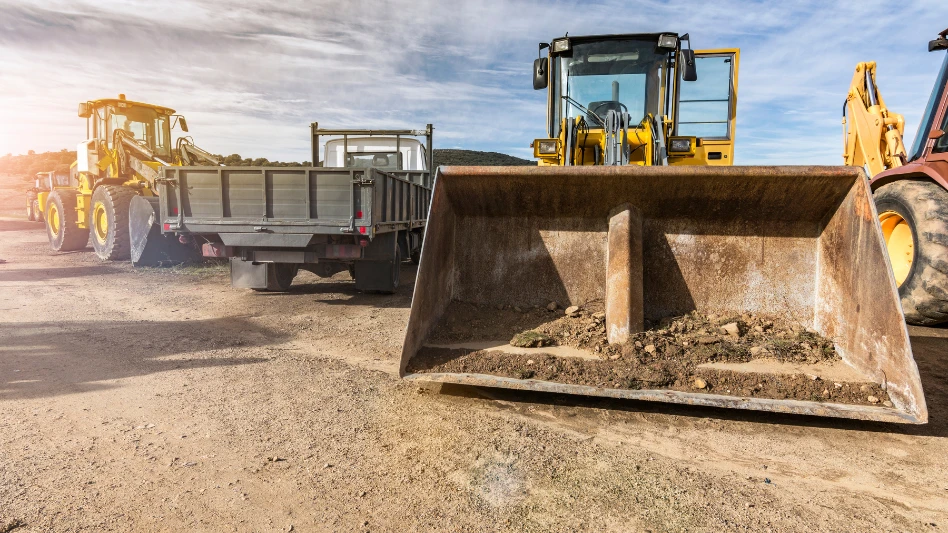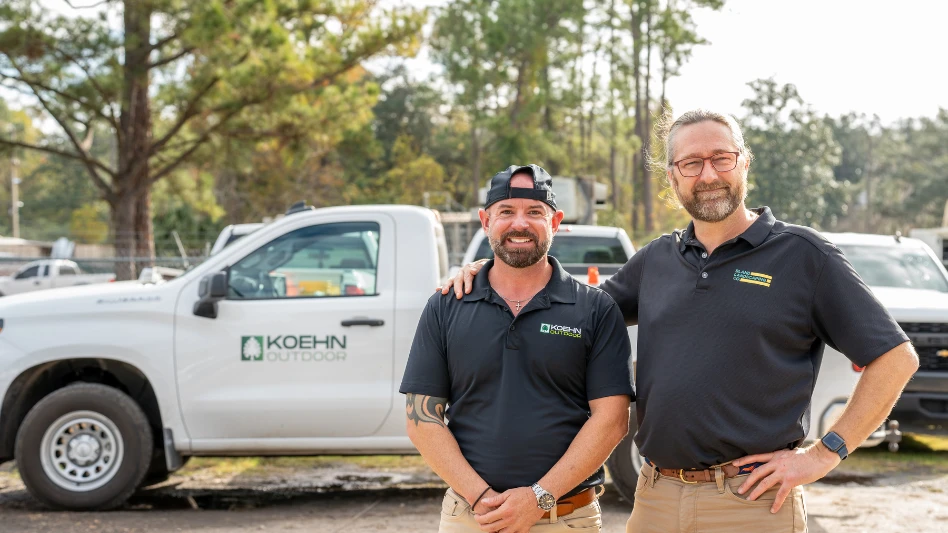 KEI’s Enrique Jimeniz and Jaime Monarrez assist each other during a landscaping project at a Milwaukee-area shopping mall. Photo: Barbara Mulhern
KEI’s Enrique Jimeniz and Jaime Monarrez assist each other during a landscaping project at a Milwaukee-area shopping mall. Photo: Barbara Mulhern
Overexertion injuries are common in our industry, often painful for employees and can be extremely costly for employers. According to the 2007 Liberty Mutual Workplace Safety Index, overexertion injuries were responsible for $12.7 billion in direct costs to businesses in the U.S. in 2005 – more than any other type of injury. Liberty Mutual defines overexertion injuries as those resulting from lifting, pushing, pulling, holding, carrying or throwing.
Within the landscape services industry, the U.S. Bureau of Labor Statistics (BLS) Survey of Occupational Injuries and Illnesses reported 9,940 overexertion injuries resulting in days away from work from 2003 through 2007. Sixty-two percent of those injuries resulted from overexertion when lifting. Landscape services workers perform such tasks during landscape and irrigation installation, lawn care, tree trimming and removal, general landscape maintenance and snow removal.
“Our experience is that overexertion resulting in back and shoulder injuries and slips, trips and falls most commonly result in ergonomic injuries in landscaping,” says Andy Benson, a risk improvement engineer with EMC Insurance Companies.
An EMC Tech Sheet, Back Safety & Lifting Techniques, notes that back injuries account for one of every five workplace injuries or illnesses at U.S. companies overall – and that one-fourth of all workers’ compensation indemnity (lost time) claims involve back injuries.
|
Back Talk |
Taking Action
A visit to nearly any landscape maintenance or construction job site will clearly demonstrate how overexertion and other ergonomic injuries can occur.
In fact, you don’t even need to leave the equipment yard to see crewmembers jumping on and off of trucks, overreaching while loading trucks or carrying heavy pots and other loads that weigh more than 50 pounds.
At job sites, the many ways overexertion and other ergonomic injuries may occur include twisting the body while manually lifting flagstone or other construction materials, repeatedly bending from the waist instead of from the knees, working in awkward positions or manually pulling large trees and shrubs from the ground.
“In landscape maintenance, almost every piece of equipment used has a constant vibration that can affect the hands and forearms, resulting in an ergonomic injury – trimmers, walk-behind mowers, blowers, riding mowers. Even spraying with its constant squeezing of the trigger needs to be watched,” says Rick Rollo, vice president of Kujawa Enterprises in Oak Creek, Wis.
In 2005, after determining most of its employee injuries were occurring within its maintenance department, KEI approached its insurer, EMC Insurance Companies, for a solution. The result was the formation of a four-month Maintenance Task Force, composed of an insurance company representative and department crew members and crew chiefs.
The task force report presented to KEI management in 2005 included the following information:
- 46 percent of the workers’ compensation claims filed within the maintenance department from January 2000 through August 2005 were for sprains.
- Nearly 41 percent of the workers’ compensation claims dollars spent during that time period were for claims involving sprains.
- The most common body parts affected by injury during that period were the hands (21.8 percent) followed by the back (20.8 percent).
The report identified 18 tasks commonly performed by KEI maintenance workers that resulted in overexertion, sprains or other ergonomic injuries. The task force then identified specific risk factors and proposed for each task.
For example, the first task identified was edging – pulling weeds by hand – which was resulting in overexertion or sprains to the back and shoulders and bruises and soreness of the knees. Proposed solutions were to stretch the muscles for approximately five minutes before starting the task and providing edging crewmembers with knee pads, which cost about $20 each.
“We have since supplied knee pads to whoever requests them,” Rollo says.
Other identified risky tasks included pouring pesticides from a 55-gallon drum into a bucket, manually lifting five-gallon buckets onto trucks and filling the tank with chemicals using the five-gallon buckets.
Since the task force report, KEI has supplied hand pumps for certain chemicals and has put others into more manageable containers. “We also designed and had built a whole new truck with enclosed tanks, ramps to the back of the truck and side loading with a forklift. We had the guys in the division help us design and set up the vehicle, and it is much safer and more convenient,” Rollo says.
What was the result of all of KEI’s efforts to reduce ergonomic injuries and workers’ compensation claims within its maintenance department? According to Benson, data based on first reports of loss shows that companywide, KEI is now averaging 1.3 workers’ compensation claims per month compared to 2.4 claims per month prior to the task force report. “And the maintenance department claim rate appears to have gone down about 40 percent,” he says.
Here are some steps all landscape and lawn care companies can take to reduce injuries and claims:
- Work with your workers’ compensation carrier to identify the sources of your claims and how much each type of claim is costing your company. If you learn that ergonomic injury claims are prevalent, ask your insurer to work with you in a manner similar to what KEI did in an effort to reduce these costly claims. Note: Your insurance carrier should do this as part of the cost of the annual premium you are paying.
- Ensure that you have support from top management. “The most important thing for employers is the safety culture of the company. It has to come from the top down,” Benson says. “In reality, they’re always pushing production, production, production. They need to emphasize that at the end of the day they want everyone to go home safe.”
- Provide manual (such as dollies and hand trucks) and mechanical (forklifts and skid-steer loaders) lifting devices for heavy loads. Manually lifting a load that weighs 50 pounds or more without assistance greatly increases the risk of back injury.
- Require crew members to seek assistance when they lift heavy or awkward loads.
- Train your workers in safe lifting practices and in other ways to reduce the risk of ergonomic injuries. Many free resources are available in both English and Spanish. EMC Insurance Companies’ Back Safety& Lifting Techniques also suggests the following steps to reduce the risk of back injuries:
- Review the causes of the back injuries that have occurred in the past three to five years. If accident investigation reports are available, they should be reviewed to see if recommendations for corrective action were made and were effective in preventing future injuries. If repeat injuries have occurred, this signals the need for more extensive evaluation, implementation of existing recommendations or new recommendations for corrective action.
- Reduce the amount of manual lifting. If employees don’t have to handle, lift or carry materials, they are less likely to suffer a back injury or other musculoskeletal disorder. In many cases, it is not possible to completely eliminate all lifting. In these cases, EMC suggests attempting to reduce the frequency of lifting, improve the posture of employees and/or reduce the weight of the objects being lifted.

The author is a Wisconsin-based writer who has specialized in green industry safety issues for past 15 years.

Explore the December 2009 Issue
Check out more from this issue and find your next story to read.
Latest from Lawn & Landscape
- Analysis of an entrepreneur
- Terra Nova's Sedum Conga Line variety wins Best of 2024 Perennial award
- Different ways to distribute
- Case's 580EV electric backhoe loader wins Good Design Award
- Davey Tree promotes Dan Herms to VP, GM of Davey Institute
- Caterpillar's Cheryl H. Johnson set for April retirement
- Registration open for sixth annual Lawn & Landscape Technology Conference
- 12 interview questions to help you hire winners





